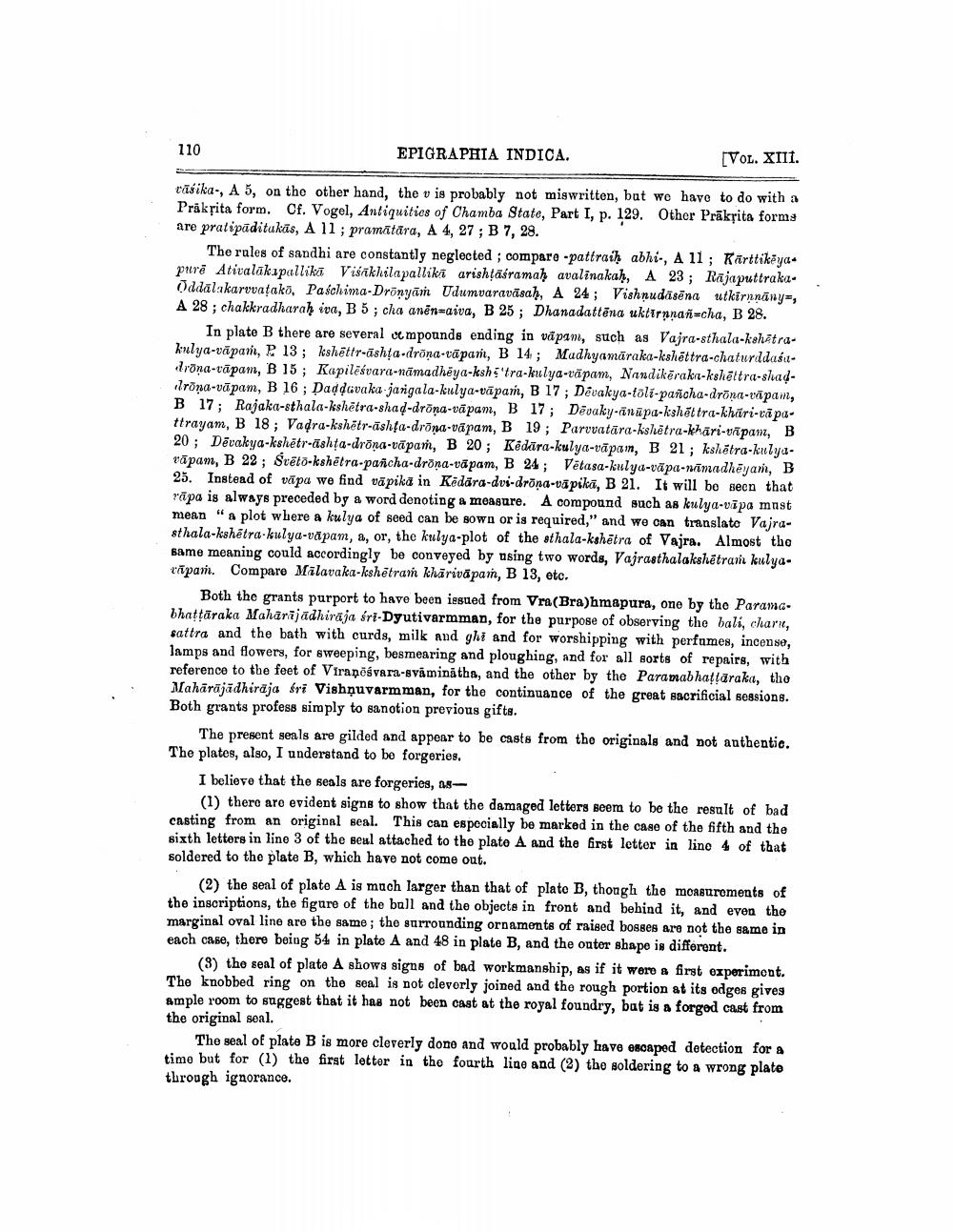________________
110
EPIGRAPHIA INDICA.
[VOL. XIII.
vasika-, A 5, on the other hand, the v is probably not miswritten, but we have to do with a Prakrita form. Cf. Vogel, Antiquities of Chamba State, Part I, p. 129. Other Prakrita forms are pratipaditakas, A 11; pramatāra, A 4, 27; B 7, 28.
The rules of sandhi are constantly neglected; compare -pattraiḥ abhi-, A 11; Kärttikeya pere Ativalskspalliks Visakkilapalliks arishidiramah aralisalah, A 23 Rajapattraks Oddalakarvvaṭako, Paschima-Dronyam Udumvaravasaḥ, A 24; Vishnudasēna utkirṛṇāny=, A 28; chakkradharah iva, B 5; cha anen-aiva, B 25; Dhanadattena uktirṛṇan-cha, B 28.
In plate B there are several compounds ending in väpam, such as Vajra-sthala-kehetrakulya-vapam, P 13; kshettr-ashta-drona-vapam, B 14; Madhyamaraka-kshettra-chaturddasadrona-vapam, B 15; Kapilēsvara-namadheya-ksh 5 'tra-kulya-väpam, Nandikēraka-kshettra-shaddrona-vapam, B 16; Daddavaka jangala-kulya-vapam, B 17; Devakya-toli-pañcha-droṇa-vapam, B 17; Rajaka-sthala-kshetra-shad-drona-vapam, B 17; Devaky-anupa-kshet tra-khari-tapattrayam, B 18; Vadra-kshetr-ashta-drona-vapam, B 19; Parvvatara-kshetra-khari-väpam, B 20; Devakya-kshetr-ashta-drona-vapam, B 20; Kedara-kulya-vapam, B 21; kshetra-kulyavapam, B 22; Sveto-kshetra-pañcha-drona-vapam, B 24; Vetasa-kulya-vapa-namadheyam, B 25. Instead of vapa we find vapika in Kedara-dvi-drona-väpika, B 21. It will be seen that rapa is always preceded by a word denoting a measure. A compound such as kulya-vapa must mean "a plot where a kulya of seed can be sown or is required," and we can translate Vajrasthala-kshetra kulya-vapam, a, or, the kulya-plot of the sthala-kshetra of Vajra. Almost the same meaning could accordingly be conveyed by using two words, Vajrasthalakshetram kulyatapam. Compare Malavaka-kshetram kharivapam, B 13, etc.
Both the grants purport to have been issued from Vra(Bra)hmapura, one by the Paramabhaṭṭaraka Maharajadhiraja śri-Dyutivarmman, for the purpose of observing the bali, charu, sattra and the bath with curds, milk and ghi and for worshipping with perfumes, incense, lamps and flowers, for sweeping, besmearing and ploughing, and for all sorts of repairs, with reference to the feet of Viraposvara-svaminaths, and the other by the Paramabhaṭṭaraka, the Maharajadhiraja śri Vishnuvarmman, for the continuance of the great sacrificial sessions. Both grants profess simply to sanotion previous gifts.
The present seals are gilded and appear to be casts from the originals and not authentic. The plates, also, I understand to be forgeries.
I believe that the seals are forgeries, as
(1) there are evident signs to show that the damaged letters seem to be the result of bad casting from an original seal. This can especially be marked in the case of the fifth and the sixth letters in line 3 of the seal attached to the plate A and the first letter in line 4 of that soldered to the plate B, which have not come out.
(2) the seal of plate A is much larger than that of plate B, though the measurements of the inscriptions, the figure of the ball and the objects in front and behind it, and even the marginal oval line are the same; the surrounding ornaments of raised bosses are not the same in each case, there being 54 in plate A and 48 in plate B, and the outer shape is different.
(3) the seal of plate A shows signs of bad workmanship, as if it were a first experiment. The knobbed ring on the seal is not cleverly joined and the rough portion at its edges gives ample room to suggest that it has not been cast at the royal foundry, but is a forged cast from the original seal.
The seal of plate B is more cleverly done and would probably have escaped detection for a time but for (1) the first letter in the fourth line and (2) the soldering to a wrong plate through ignorance.




